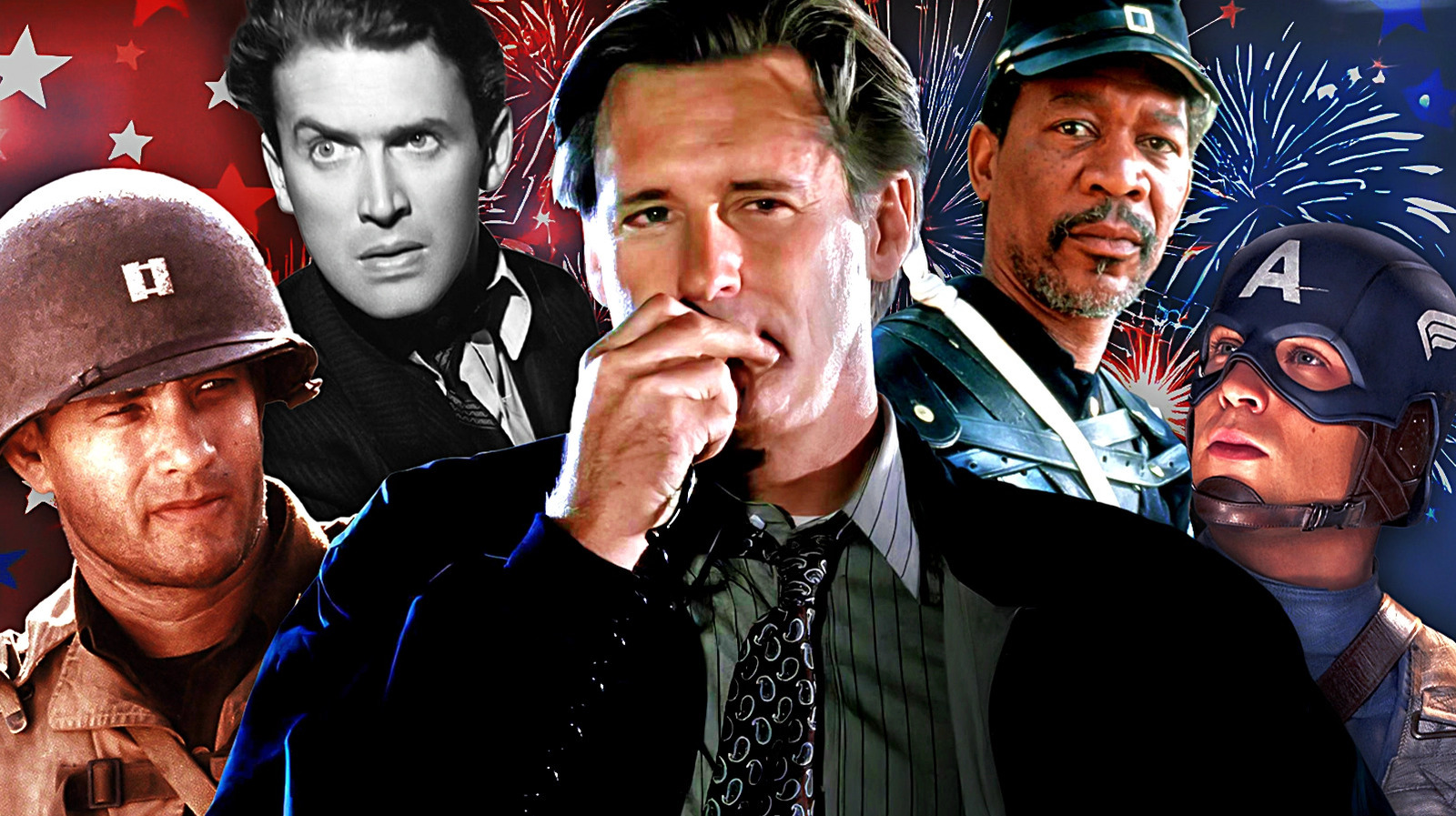
by admin | Jul 4, 2025 | TV & Beyond Articles
Roland Emmerich’s “Independence Day,” the maestro of mayhem’s masterpiece, and maybe the most summeriest of summer blockbusters ever.
Seriously, has there ever been a movie that understood its assignment better and absolutely delivered? If “Independence Day” was just a bunch of explosions, we wouldn’t still cherish it to this day. No, it’s Smith cracking one-liners and skulls, Goldblum stammering his way into saving humanity, and especially Pullman delivering one of the most goosebump-inducing movie speeches ever, still sending chills down our spines nearly 30 years later (yes, you’re old). Sure, we’re going to pretend the 2016 sequel nobody asked for never happened (why make a sequel to a Will Smith movie without Will Smith?) because we’ll always have the incredible original.
Born on The Fourth of July

Universal Pictures
America’s nearly two-and-a-half century story is not all sunshine and rainbows. But hey, you’d probably make some mistakes too if you were 250 years old. While we have so much to be proud of, the shameful treatment of soldiers before, during, and after the Vietnam War is not one of them. The second film in Oliver Stone’s unofficial Vietnam trilogy, “Born on the Fourth of July,” tells this essential, if painful, story with a biopic of Vietnam veteran turned anti-war protester Ron Kovic.
If you’re a young viewer who only knows Tom Cruise as the vampire man from the “Mission: Impossible” films who still does life-threatening stunts in his early 60s, it’ll be a revelation to see what a powerful actor he was in his late 20s. “Born on the Fourth of July” remains one of Cruise’s best performances, nearly four decades since its release, but he owes much of that to his director. Stone is a decorated Vietnam veteran himself, and imbues his war films with a pathos and authenticity that only a veteran can. “Born on the Fourth of July” isn’t an easy watch, but it is a necessary one, on Independence Day or any day.
The Patriot
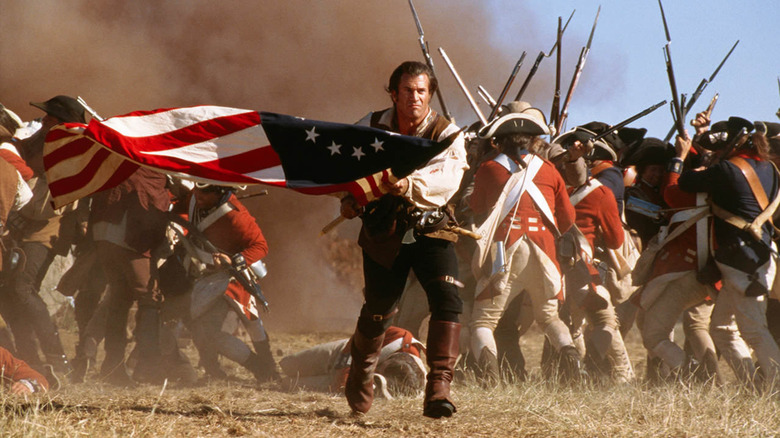
Columbia Pictures
Contrary to popular belief, America’s independence from the British Empire was not won by General George Washington, Commander-in-Chief of the Continental Army, or even the U.S. Army itself, but single-handedly by Mel Gibson. Glad I could clear that up. Okay, “The Patriot” does turn the entire Revolutionary War into an action-packed revenge pic, but y’know what … So what? Don’t watch “The Patriot” as a history lesson, but because it’s a really awesome way to spend two hours and 45 minutes.
The master of disaster, Roland Emmerich, may hail from Stuttgart, Germany, but the dude loves the red, white, and blue, as he’s the only director with two movies on this list. Four years after he showcased humanity taking down space invaders in “Independence Day,” he celebrated America taking on Redcoats by way of Benjamin Martin (Gibson), a widowed farmer with a dark past (basically, Det. Martin Riggs from “Lethal Weapon,” but in colonial South Carolina) who discovers the best way to protect his family is to secure a young nation’s freedom. Hell. Yeah. If you love America, or really love shoot ’em ups, “The Patriot” is worth fighting for.
Argo
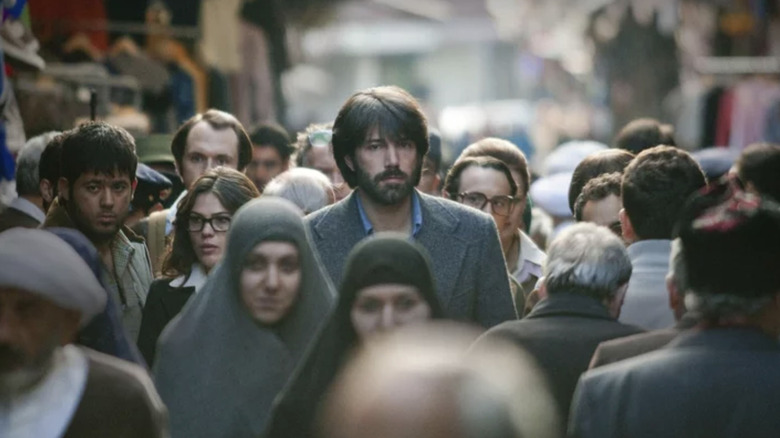
Warner Bros.
America loves a comeback story, and few filmmakers in Hollywood have had a bigger one than Ben Affleck. The dude behind duds like “Reindeer Games,” “Jersey Girl,” and the most notorious bomb of all, “Gigli” was well on his way to being a “Jeopardy” category under “Guys Who Used To Be Famous,” but managed to go from “box office poison” to Academy Award winner in less than a decade. The reason was “Argo.”
The 2013 Best Picture winner stars Affleck as Tony Mendez, a CIA extractor charged with rescuing six American hostages who escaped the U.S. embassy in Tehran during the Iranian hostage crisis of 1979. Mendez comes up with the genius idea of posing as a Canadian film crew scouting locations in Iran for their cheesy sci-fi flick, “Argo.” If it sounds too crazy to be true, it’s not. “Argo” is worth a watch anytime, but especially merits inclusion during your July 4 movie marathon as it celebrates American heroism and ingenuity. While the director of “Gigli” saw his career unceremoniously ended, I’m certainly thankful Ben Affleck didn’t.
Any Rambo movie
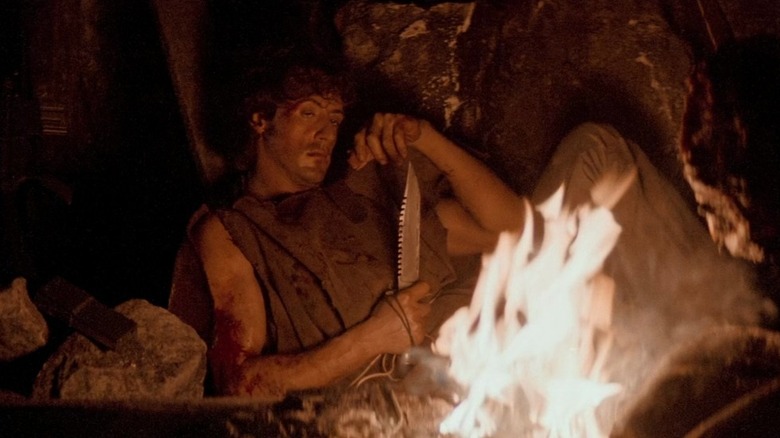
Orion Pictures
I’m putting any Rambo movie here because, well, you should watch any of the five John Rambo movies on the 4th of July. Or heck, you could just turn Independence Day into “John Rambo Day” and watch all of them, just like the Founding Fathers intended. That said, which one you watch depends on your mood. You could go with the somber and serious “First Blood,” the awesomely ’80s action pic “Rambo: First Blood Part II,” the one-man-army insanity of “Rambo III,” or the “badass old guy has still got it” legacy sequels “Rambo” and “Rambo: Last Blood.”
Really, any (or all) of them will do. John Rambo was born from the brain of novelist David Morrell for his 1972 action-thriller novel, but Morrell was thinking too small and decided to *gasp* kill off his main character! While that ending was totally in line with the bleak worldview of the early 1970s, it was out of fashion by the early 1980s. “First Blood” director Ted Kotcheff and star and co-screenwriter Sylvester Stallone rightly believed killing Rambo would be a major bummer. Worse, it’d deprive us of sequels. While the first is obviously the best, each “Rambo” adventure is sweet.
Air Force One
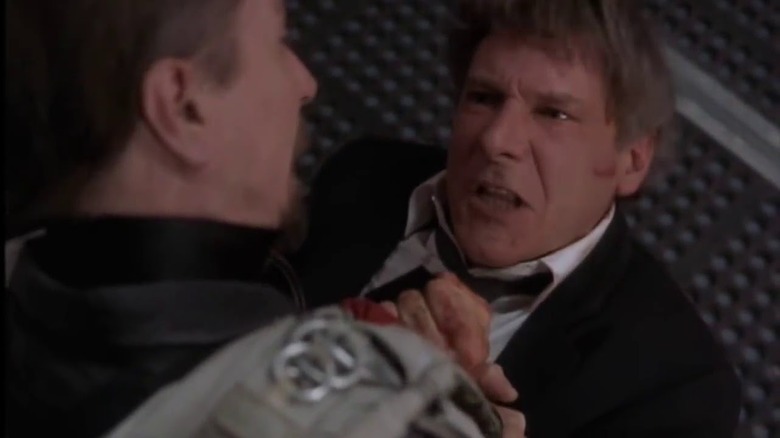
Columbia Pictures
The setup (and appeal) of “Air Force One” is summed up by the poster: “Harrison Ford is President of the United States.” Because even during times of division and discord, there’s one thing every red-blooded American can all agree on: Harrison Ford should be President. Or at least, his “America’s Dad” movie persona, in the form of President James Marshall. Alas, watching Ford, or anyone for that matter, sign legislation into law and make speeches to donors at $500-a-plate rubber chicken dinners would be pretty boring.
Thankfully, “Air Force One” gives us President Ford fighting commie radicals who hijack his plane, kidnap his family, and hold the most powerful person in the free world hostage unless he frees some bad guy from prison. Too bad they picked the wrong POTUS. If that weren’t enough, the villain is played by Gary Oldman in one of his most underappreciated (but oh so hammy) performances. Also, “Air Force One” gave us one of the greatest Harrison Ford movie quotes. What more do you need? Just go watch “Air Force One” already!
Saving Private Ryan
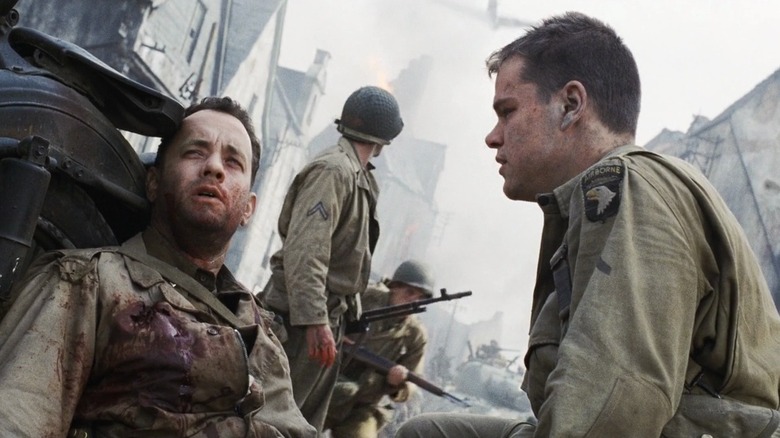
Paramount Pictures
“Saving Private Ryan” is one of the best movies of the ’90s and one of the greatest war movies ever made. It should also be a Best Picture winner, but that’s another story (sorry “Shakespeare In Love” fans, but come on!). In the aftermath of the Vietnam War, our culture lost perspective on just how bloody and brutal World War II was. Steven Spielberg managed to teach a new generation that just because World War II was a “good” war, it didn’t come without an incredible cost, one borne most deeply by the everyday men sacrificing life and limb to fight it.
“Saving Private Ryan” famously features one of the most graphic (and thus effective) battle scenes in film history, and all in the first 30 minutes. While the film is rightly celebrated for the Normandy invasion, what follows is the criminally underappreciated rest of the movie, an old-school “men-on-a-mission” war movie, but one imbued with profound pathos. “Saving Private Ryan” honors the greatest generation who fought and died nearly a century ago; a great way to celebrate Independence Day.
Patton
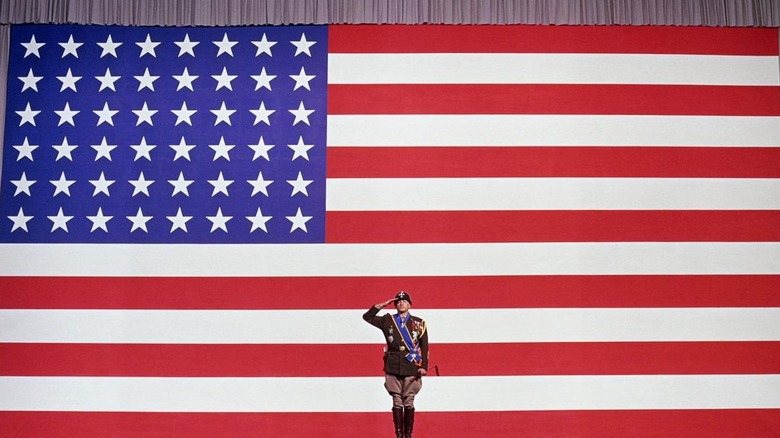
20th Century Studios
“So-and-so was born to play _____” is a phrase thrown around to the point of cliche. But it certainly applies to George C. Scott’s Academy Award-winning performance in the title role of “Patton.” Numerous big names were rumored to be up for the part, including Robert Mitchum, Burt Lancaster, Rod Steiger, and John Wayne. While I could maybe see Steiger pulling it off, I’m glad I live in a timeline where Scott plays the part. Rarely if ever has an actor better embodied his character’s personality and contradictions than Scott did in “Patton.”
General Patton had a nickname as “Old Blood and Guts,” and he earned it. He was colorful, charismatic, a total bully, and indisputably one of the key reasons the Allies were victorious in the most consequential conflict in human history. Just because the good guys won doesn’t mean every one of them was a “good” guy, and “Patton” doesn’t shy away from showing the general’s darker side, such as slapping a shellshocked soldier with PTSD and sending him to the front lines. But “Patton” also makes clear we needed battle-hardened warriors like Patton to win World War II.
Glory
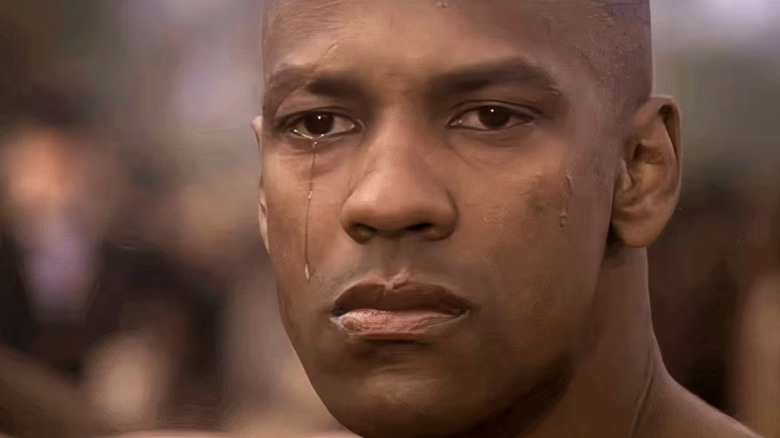
Tristar Pictures
The Civil War was the bloodiest in American history, taking the lives of anywhere from 620,000 to 750,000 men. More Americans lost their lives in that four-year conflict than any other before or since, but that tends to happen when it’s brothers fighting brothers, in a clash to end the miserable institution of slavery. No film could possibly convey the enormity of the conflict, but few films come closer than “Glory.”
Matthew Broderick stars as Col. Robert Gould Shaw, the young commander of the United States’ first all-Black regiment. While watching Ferris Bueller command men in the field of battle (“Glory” came out just three years after the John Hughes classic) seems like a stretch, Broderick serves as the film’s emotional heart. Meanwhile, Morgan Freeman does what Morgan Freeman does best as the movie’s moral center. But the movie’s spirit belongs to Denzel Washington in an Oscar-winning role as escaped slave Trip, an understandably angry man whose raw, feral energy hides a deep-seated bitterness. Add all of these elements, plus Edward Zwick’s sweeping filmmaking and James Horner’s powerful score, and you have one of the best Civil War movies ever made.
Captain America: The First Avenger
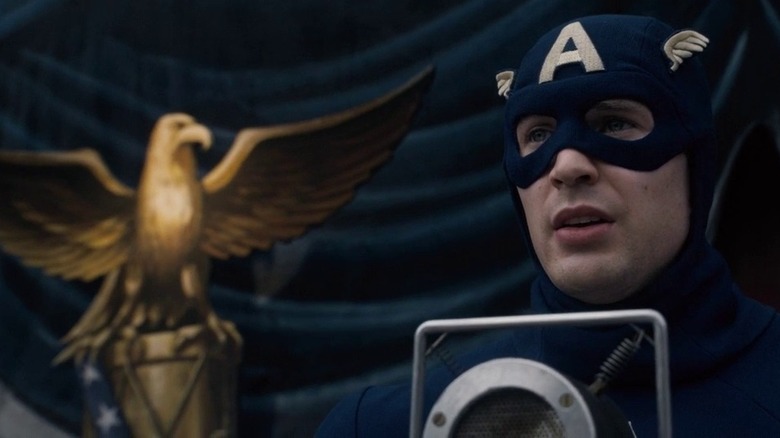
Marvel Studios
Apologies to Martin Scorsese, but we couldn’t have a summer movie list without including at least one superhero movie, now could we? The question is, which one? I considered giving props to the big blue Boy Scout who stands for “truth, justice, and the American way,” or maybe the yellow lasso-twirling, red, white, and blue-wearing heroine of Themiscyra. But I opted for a film with the superhero who literally has “America” in his name: “Captain America: The First Avenger.”
I’ve lost count on how many Marvel Cinematic Universe movies (25? 30? 40? 400?) have come out since this 2011 flick, which was the fifth film in Marvel’s Phase 1 and the last before “The Avengers” broke all the records and changed everything. If you decide to rewatch “Captain America,” you’ll find it holds up, not only as an early entry in the long-running mega-franchise but on its own as an old-fashioned summer blockbuster. You don’t need to know what happens to enjoy Cap; you just need to love Steve Rogers’ heroism, idealism, patriotism, sense of right and wrong, and willingness to sacrifice himself for the greater good.
Any Rocky movie

United Artists
Is there any story more American than Sylvester Stallone’s “rags-to-riches” tale? Rarely has a creator’s story paralleled their creations more than Stallone and Rocky Balboa. Similar to how “The Italian Stallion” was a journeyman pugilist who thought his shot at stardom had passed him by, Stallone was a young, but often out-of-work actor who wasn’t getting cast in the parts he wanted (or really any parts, period), so he wrote his own, making himself a movie star in the process.
America loves an underdog, but it also loves a winner. Good thing the “Rocky” and “Creed” franchises are about both. You could do a six-film “Rocky” marathon, a three-film “Creed” countdown, or heck, if you feel like you can go the distance, just watch all nine to get the complete story. But if you’re pressed for time (or want to watch some of the others on this list), I recommend sticking with the 1976 original. Besides winning Best Picture, it set the stage for the entire franchise and introduced us to one of our country’s most inspirational cinematic heroes.
Mr. Smith Goes To Washington
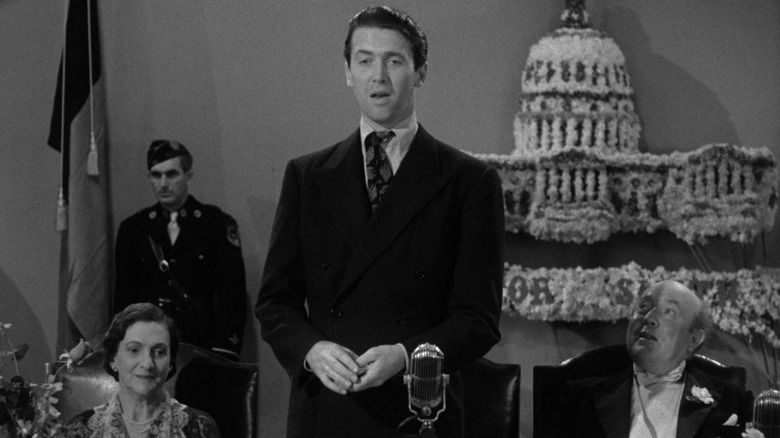
Columbia Pictures
Jimmy Stewart is cinema’s all-American Everyman, while Frank Capra is the ultimate immigrant story. Together, the two became one of the greatest actor-director collaborators in movie history, despite only making three films. Their second film, “Mr. Smith Goes To Washington,” is a big reason why. Of course, so is their third collaboration, “It’s A Wonderful Life,” but save that one for Christmas.
It seems like every election season, some fresh-faced, bright-eyed up-and-comer heads to Washington, D.C., using Jefferson Smith (Stewart) as his patron saint. Invariably — and inevitably — the would-be Mr. Smith comes up short. But that’s kinda the point. Even in 1939, Jefferson Smith was an ideal whom cynical Washington colleagues considered to be a rube and naif. They thought nobody could be that innocent, that decent, that honest … and perhaps in the real world, they’d be right. But in the movies, a guy like Jefferson Smith can exist. So even if you never run for office, characters like Mr. Smith give us all an ideal to strive for.
The Madness of King George
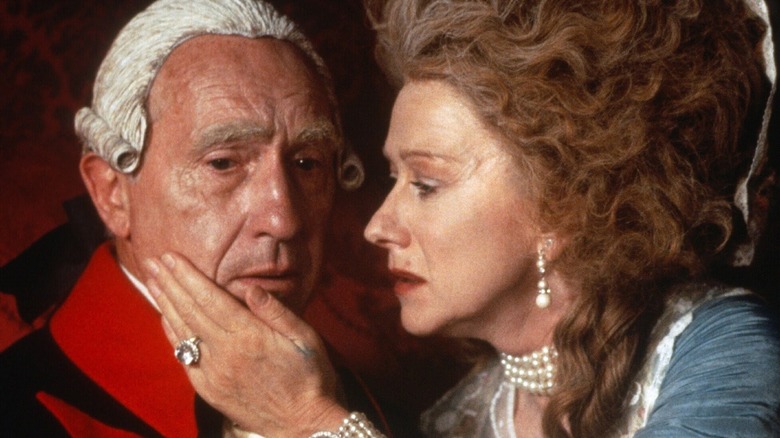
Channel Four Films
At first blush, a British film about a Royal Monarch may seem like a strange fit for this list, but consider the subject matter — King George III, the last English King to rule over the American colonies. Some scholars speculate that King George’s “madness” was brought on by the blood disorder porphyria, which contributed to his erratic and eccentric behavior and tyrannical treatment of the American colonies.
The 1994 dramedy biopic “The Madness of King George” stars Nigel Hawthorne as the titular tyrant, who goes back and forth between completely confused, totally temperamental, and downright daffy. While the doctors of the day attempt different cures, his wife, Queen Charlotte (Helen Mirren), strives to keep the King from having his throne usurped by the unctuously ambitious Prince of Wales (Rupert Everett). Okay, the movie mostly takes place after the Revolutionary War, and is a British period costume drama, but knowing what made “the last King of America” tick, and finally snap, is a fascinating part of America’s story.
Sergeant York
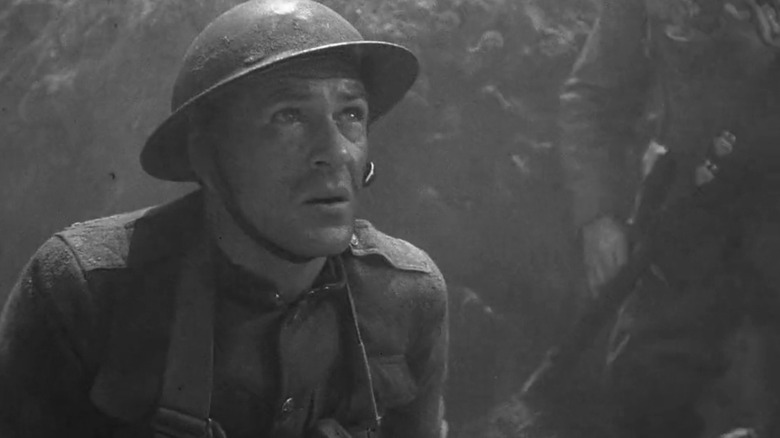
Warner Bros.
“Sergeant York” finds Gary Cooper in front of the camera and Howard Hawks behind it, doing what both men did best: Telling a story of a simple, but courageous man who stands up for what he believes in. In an Oscar-winning performance, Cooper plays Alvin York, one of the most decorated American soldiers of World War I. York starts as a hard-living, heavy-drinking good ol’ boy from the hills of rural Tennessee, but converts to Christianity and turns his life around, along the way becoming a prize-winning marksman.
But when the Great War from overseas shows up on his front door, York’s devotion to his pacifist beliefs comes into conflict with his desire to serve his country. Released in 1941, just a few months before Pearl Harbor, the isolationist York being forced to fight in World War I provides a clear parallel to America’s situation on the eve of World War II. “Sergeant York” is not only a fascinating time capsule but also a quality entertainment that stands the test of time.
Top Gun and Top Gun: Maverick
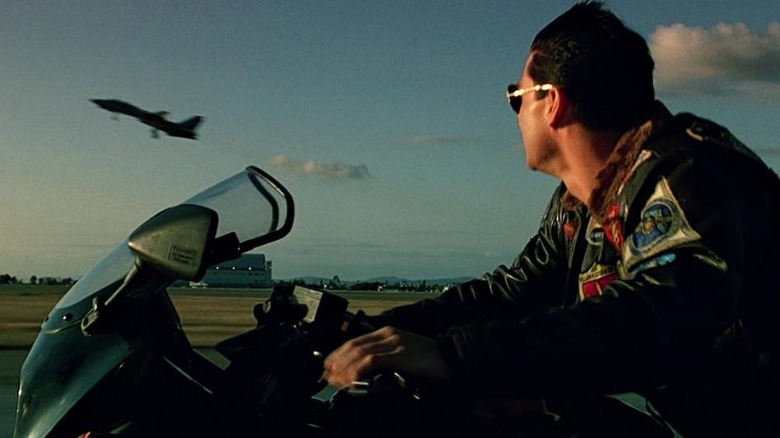
Paramount Pictures
Watching Tom Cruise blow up stuff is as American as apple pie, so if you have a need for speed, grab yourself a big ol heaping slice of action-packed mayhem with the twin tales of Captain Pete “Maverick” Mitchell. The 1986 original is, of course, a classic, with a pop culture imprint that’s still being felt almost 40 years since it first flew across our screens from sea to shining sea.
Following in its legendary wake would be all but impossible, but Cruise knows a thing or two about that. “Top Gun: Maverick” manages to be an all-around better blockbuster than the original (and most summer movies for that matter), making it one of the greatest legacy sequels of all time. The first “Top Gun” is iconic. The second one is an action movie masterpiece. It’s pretty darn difficult asking me to pick between “Top Gun” and “Top Gun: Maverick.” So y’know what? I won’t. Before you blow up fireworks, fly into the danger zone, and make sure you watch both “Top Gun” flicks for your 4th of July movie marathon!
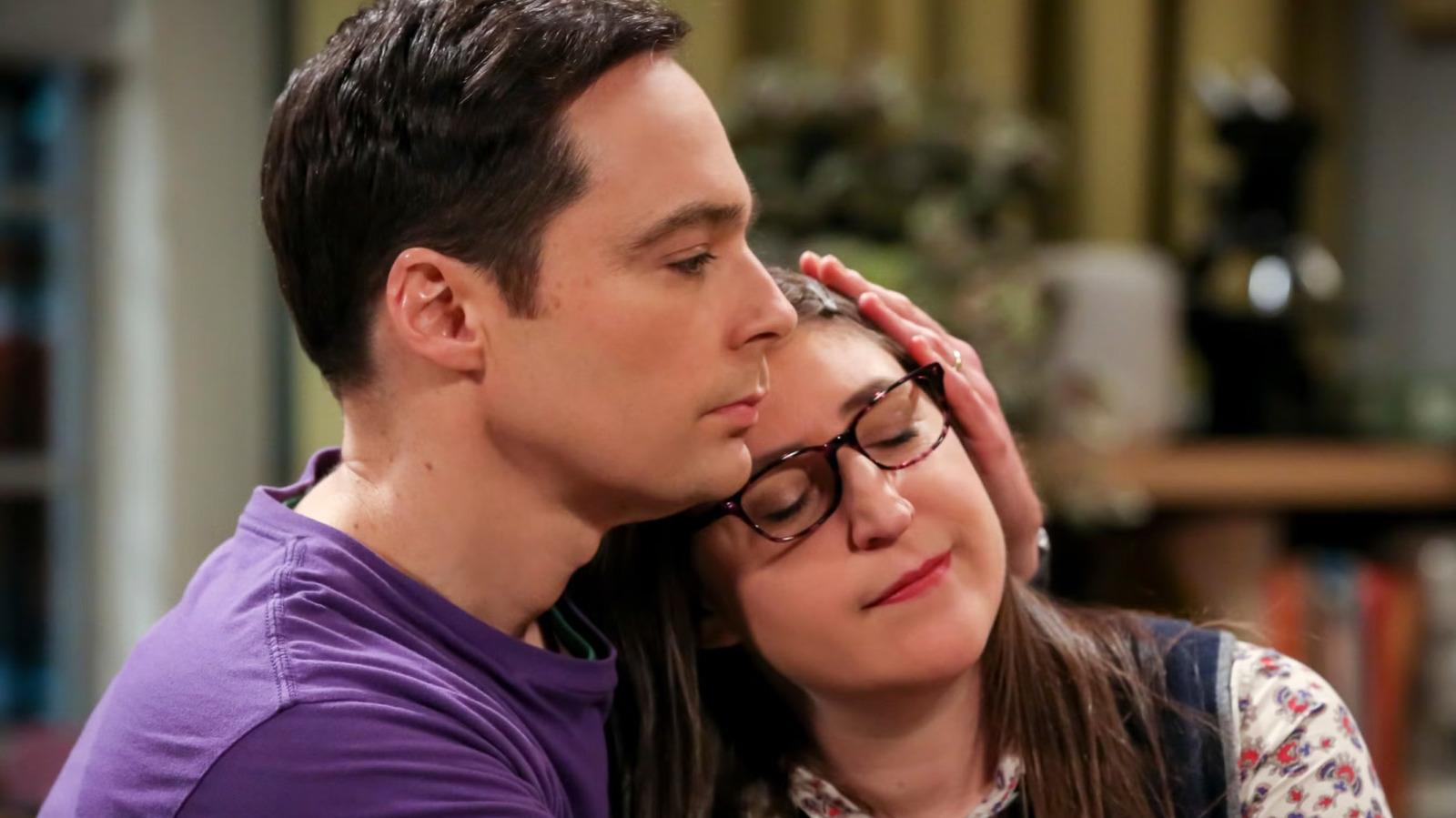
by admin | Jul 4, 2025 | TV & Beyond Articles
the lead character of Sheldon Cooper, played by Jim Parsons on “The Big Bang Theory,” was supposed to be asexual — but that particular identity changed when the character of Amy Farrah Fowler was introduced at the end of season 3. Played by former “Blossom” star and actual neuroscientist Mayim Bialik, Amy is a match for Sheldon in every way, even though she’s much more interested in pursuing the physical aspects of their relationship than he is. To that point, Bialik said that a season 5 episode where a distraught Amy asks Sheldon to cuddle with her is her favorite moment between the couple and a career highlight for her overall.
“With Jim, I get to play a lot of subtlety,” Bialik said in a behind-the-scenes video about the season, following her take on the relationship between Amy and Kaley Cuoco’s Penny, which is … less subtle, to put it lightly. “I think the cuddling with Sheldon scene was my favorite, though, and really one of my favorite moments as a performer in general.”
That cuddling comes about in the episode “The Isolation Permutation,” where Amy feels left out after her two girlfriends, Penny and Bernadette Rostenkowski (Melissa Rauch), go shopping for bridesmaid dresses for Bernadette’s upcoming wedding and don’t extend an invite to Amy. Understandably, this hurts Amy’s feelings, and after she goes radio silent for a while, she asks Sheldon to console her with some cuddling, and the ensuing scene is just as physically awkward as you can expect (considering that Sheldon Cooper is involved). Ultimately, it’s a sweet scene … and proves that bringing Amy into the “Big Bang Theory” universe was the right call.
Bringing Amy into the world of The Big Bang Theory as Sheldon’s partner was a big risk — but it paid off

CBS
In Jessica Radloff’s 2022 book “The Big Bang Theory: The Definitive, Inside Story of the Epic Hit Series,” writer and executive Steve Molaro shared something interesting: adding Amy into “The Big Bang Theory” was a little complicated, largely because she was originally intended to just be “Sheldon, but girl.” According to Molaro, the key was that they just let Bialik play Amy and see where it all went. “We, in the writers room, were into it, but we didn’t know where it was going to go,” Molaro said of this vital addition to the show’s central cast. “But we went into it like we do with all additions to the show and all the characters: We’re hopeful and trying to do our best to make it grow into something better and interesting; that was one of those that obviously did. But it took a little while to shake off the ‘female Sheldon’ description and let her become her own person.”
“There was some negative attention when I joined the cast because some people held Sheldon very near and dear to them and didn’t want him to change or become a cheesy boyfriend,” Mayim Bialik clarified to Radloff. “To me, there was never a chance of that, and I think our writers actually handled that arc of him becoming more interested in romance very, very well.”
In fact, Bialik — and Amy — became so beloved on set that Jim Parsons said he would do basically anything to keep both the actress and character on board. “I know at the audition they said they needed a female version of Sheldon, basically, but that’s untenable long-term. There was no choice but to involve the character,” Parsons shared. He continued:
“And at some point in season 4 — I don’t know if something caused it or not — I remember saying to [Parsons’ husband Todd Spiewak], ‘I will not let this character go without a fight.’ That was notable for me, only in that I almost never disagreed with the writers. But at some point I felt a certain way about working with Mayim that was like, If for whatever reason we seem to be weaning her off of this show as a character, I would go and talk to them. I said this years ago, but I believe it even more now that one of the smartest things that the writers room ever did was introduce Bernadette and Amy at a point where, as far as interests and storylines go, we did not need them yet […] They plugged these people in to see what was going to work and how it would work, and I thought it was genius.”
Another big milestone for Sheldon and Amy has a hilarious real-life backstory
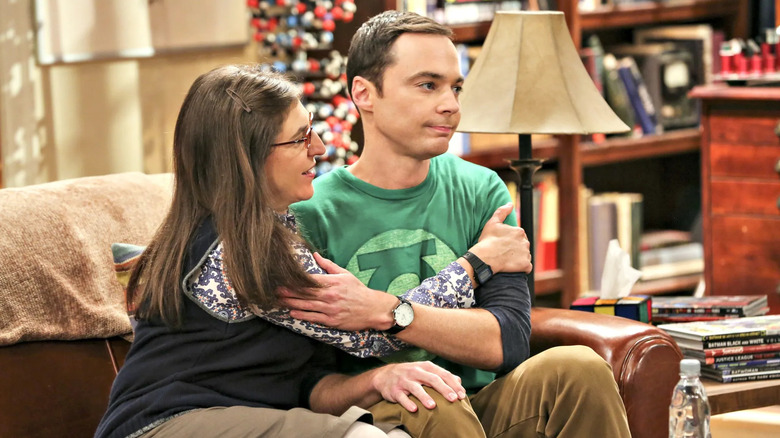
CBS
Later, in the eighth season of “The Big Bang Theory,” Amy and Sheldon experience a landmark first in that season’s premiere episode, “The Locomotion Interruption.” This moment ended up being just as special as that awkward cuddle, but here’s the inside story on this other major relationship milestone: their first kiss. This episode, which takes place after Sheldon “ran away” on a train — leaving Amy dejected — features the couple’s first legitimate kiss, because I’m not counting the one where Amy is drunk and throws up right after the smooch. According to Jessica Radloff’s book, though, it was a bit challenging to film this for one specific reason … Jim Parsons was really, really sick.
“I was sick with something, like a bad respiratory cold,” Parsons recalled. “And it was ironic because I always took care of myself, and here I am sick during one of the very rare times I have to kiss her. And kiss her several times because I knew we’d have to do several takes. I was like, This is unbelievable! I felt bad about it, I really did. Mayim is always very game and never one to worry about those things too much, although she did have some sort of a thing that she was gargling every time we did a take.” Steve Molaro did go ahead and confirm something about that gargling: “Yep, Mayim was pounding Listerine between every kiss. Jim was really sick.”
Parsons was apparently visibly sweating and feverish, so Bialik rinsed her mouth out with peroxide in between every kiss, every scene, and every take, to keep her from also getting sick. “It’s such a great scene, and it turned out so great, but it was a really hard night,” she added.
“To think of all the work that went into it, I’m so glad it was so sweet,” Bialik went on. “I really loved it. Oh, and I did not get sick.” Pretty much all of Sheldon and Amy’s relationship milestones on “The Big Bang Theory” were exciting on and off screen, and you can experience them on HBO Max, where the full series is streaming.
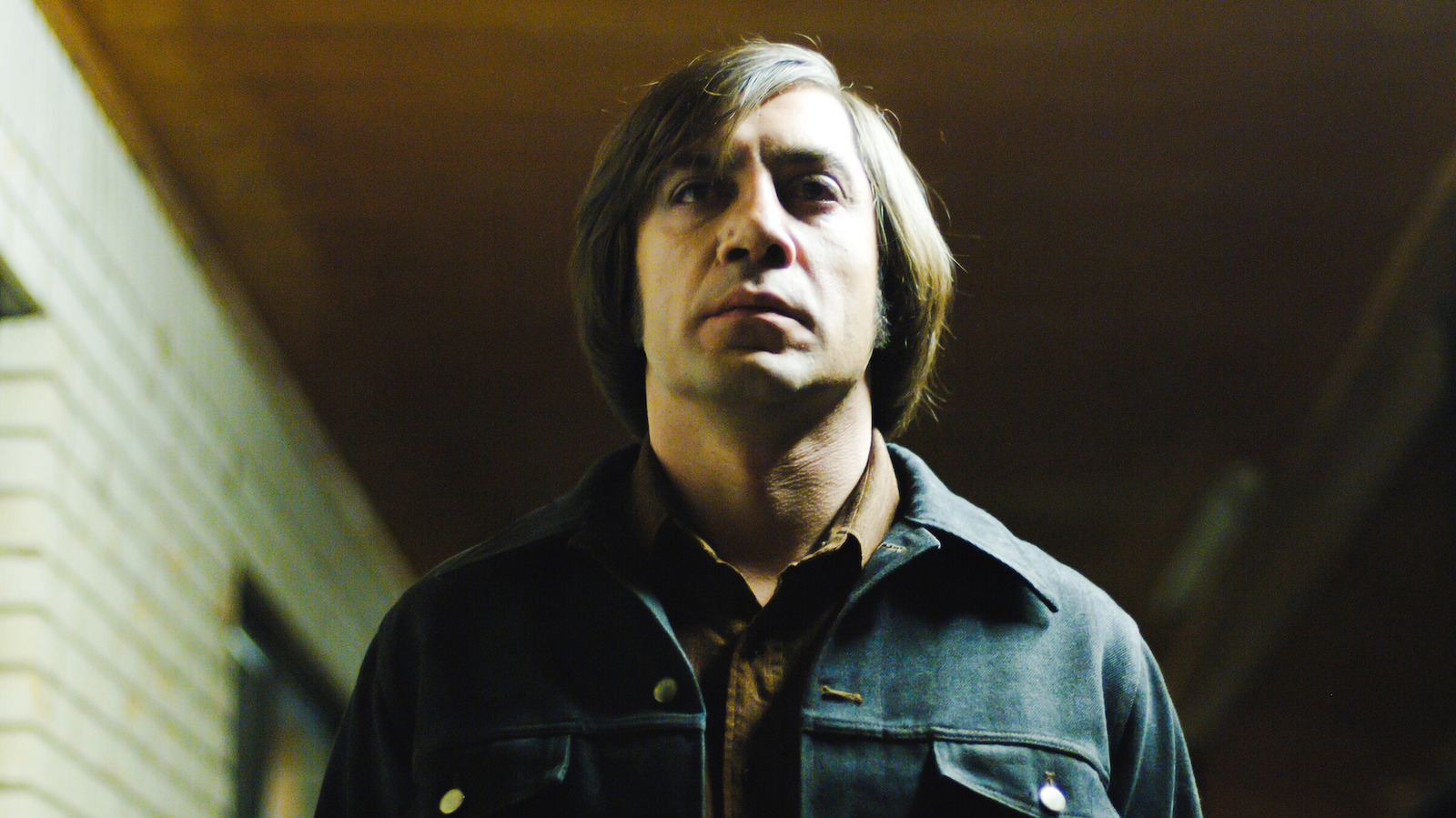
by admin | Jul 4, 2025 | TV & Beyond Articles
New York Times’ “Best Movies of the 21st Century” list and regularly named as one of the best Westerns of the past 25 years, “No Country for Old Men” was a stunning return to form for Joel and Ethan Coen in the mid-2000s. Following two of the worst comedies of their career (“Intolerable Cruelty” and “The Ladykillers”) they turned to Cormac McCarthy’s 2005 novel as inspiration for one of their best films. The siblings had adapted other people’s material before, such as Dashiell Hammett’s “The Glass Key” for “Miller’s Crossing,” but they previously put their unique Coenesque spin on it. On this occasion, the Brothers kept it fairly faithful to the book and produced what was widely regarded as their most mature film to date.
Ditching their trademark loquacious dialogue and eclectic soundtracks, the film was a return to the wide open Texan spaces and deadly silences of their terse debut, “Blood Simple.” The usual pessimism, which was previously offset by quirky humor, bursts of outlandish violence, and oddball genre twists, hardened into something more sorrowful and profound. Everybody just ate it up. “No Country for Old Men” was a critical and commercial success and won four of the eight Oscars it received nominations for, including a prestigious hat-trick for the Brothers (Best Picture, Director, and Adapted Screenplay). Let’s take a closer look.
What happens in No Country for Old Men?
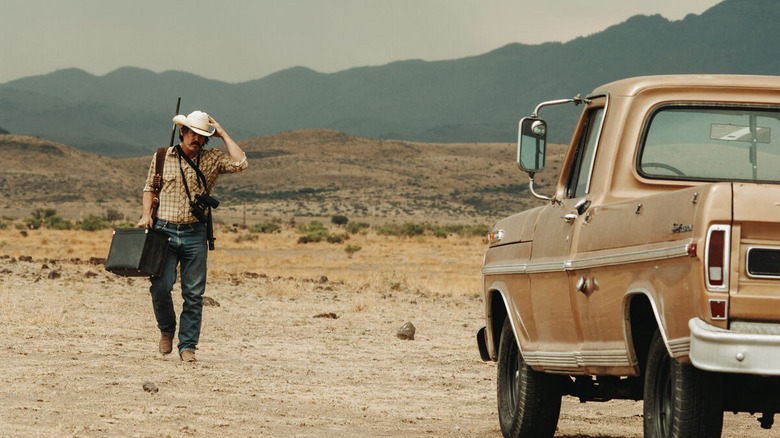
Miramax Films/Paramount Pictures
Set in Texas in the early 1980s, “No Country for Old Men” opens with ageing sheriff Ed Tom Bell (Tommy Lee Jones) lamenting about the old days when lawmen like himself didn’t need to carry a gun. Approaching retirement and struggling to understand the violent modern world, his last case will reinforce his pessimism: As he speaks, we watch as one of his deputies is brutally murdered by Anton Chigurh (Javier Bardem), a mysterious assassin whose weapons of choice are a captive bolt pistol and a heinous haircut.
Elsewhere, Llewelyn Moss (Josh Brolin) is out in the desert hunting when he stumbles upon a grisly scene. A drug deal has turned into a bloodbath leaving only one mortally wounded survivor, a whole heap of drugs, and a bag containing $2 million. Moss takes the cash and heads home to his wife Carla Jean (Kelly Macdonald), but returns later that night, feeling guilty about ignoring the dying man’s plea for water. It’s too late, and Moss only narrowly escapes with his life when other gang members arrive to retrieve the money.
Sending Carla Jean to stay with her mother for safety, Moss heads down towards Mexico with the loot. Chigurh is hired to retrieve the cash, aided by a tracking device hidden inside one of the bundles. Carson Wells (Woody Harrelson), a bounty hunter, offers to protect Moss in exchange for the money, but meets a similar fate when he encounters the killer. Bell is also on the case of the cartel shootout, belatedly following Chigurh and his prey southwards. But can he intervene in time to save Moss and his wife?
“No Country for Old Men” is one of the Coen brothers’ most assured and suspenseful films, a neo-western of such elegiac power that it finally silenced the critics who once dismissed them as snarky young misanthropes who were all style and no substance. It was also an authoritative bookend to the first two decades of their career, stripping back most of their usual stylistic quirks and letting the story do the telling. Working with master cinematographer Roger Deakins, the frame is often filled with empty expanses of landscape, suggesting that mankind’s presence is only fleeting. The Coens’ cause was aided by uniformly excellent performances, in particular from Brolin, Jones, and the Oscar-winning Bardem, who portrayed Chigurh with a serene sense of malevolence.
No Country for Old Men encapsulates many of the Coen brothers’ favorite themes
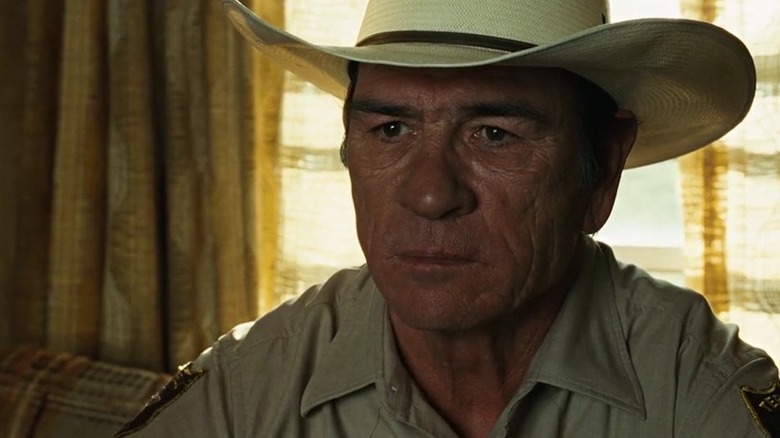
Miramax Films/Paramount Pictures
On the surface, “No Country for Old Men” is another of the Coen Brothers’ scrambles for a bag of cash, a familiar trope that allows them to explore humanity in its all fallibility, greed, absurdity, and proneness to the whims of destiny. In their world, a merciful choice like sparing a man’s life (“Miller’s Crossing”) can prove just as dangerous as an unethical one (“A Serious Man”) — it’s all the same to the cosmos, and there is no way of knowing the arbitrary outcome until after you’ve made your call. What goes around comes around, and this idea is reinforced by the Coens’ regular motif of circular or spinning objects such as hats, hula hoops, tumbleweed, tins of hair pomade. Here, the brothers’ pre-occupation randomness and fate comes down to a single coin toss.
Anton Chigurh is human. We see him bleed, which suggests he is mortal. Yet he moves through the film like a supernatural self-appointed agent of destiny, occasionally deigning to spare someone’s life if they are able to correctly call heads or tails. He seems almost otherworldly as he relentlessly pursues Moss and kills anyone else who gets in his way but, significantly, even he is subject to the same forces of destiny. Tellingly, after one victim refuses to participate in a coin toss, the outcome is deferred to him as he is involved in a random life-threatening car wreck.
“No Country for Old Men” is one of the best Coen Brothers movies and also their bleakest to date, one that captures the tense and uncertain mood in the years following the 9/11 attacks. We’re all destined to die, and our life is only shortened or prolonged by the choices we make. Against this theme, we get a classic Western white hat (Ed Tom Bell) and a black hat (Chigurh), but the odds are stacked in evil’s favor as the latter runs rampant while Bell is always two moves behind the action. By contrast, the concept of good is almost an outmoded concept as Bell fears his own irrelevance in a world he can no longer understand. Moss is just caught in the middle, a man just trying to stay one step ahead of the fate he decided for himself when he walked away with the money.
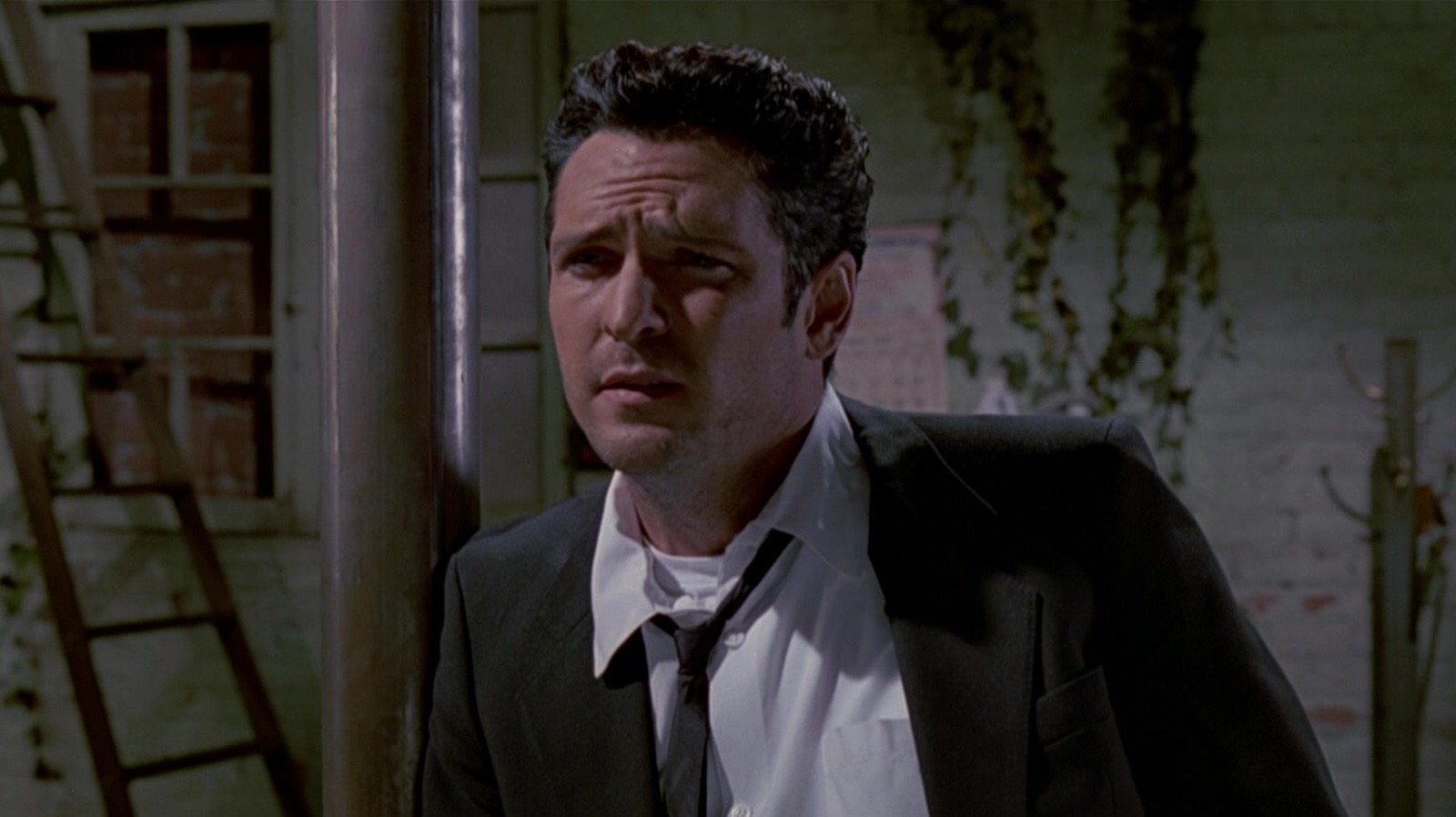
by admin | Jul 4, 2025 | TV & Beyond Articles
one of the most chaotic movie heists of all time — one that quickly descends into an equally chaotic standoff that leaves virtually everyone involved riddled with bullets. Hence, it may come as no surprise to learn that things were just as wild behind the scenes on the film.
Mr. Blonde, as played by the late, great Michael Madsen (who sadly passed away on July 3, 2025), steals Quentin Tarantino’s feature directing debut with his infamous torture routine set to the slick song “Stuck in the Middle with You.” However, even the character’s colorful personality paled in comparison to the reputation of the cast’s most problematic actor: Lawrence Tierney.
Tierney had a long history of playing mobsters in classic Hollywood pictures like “Dillinger,” and off-screen, he did his best to live up to that tough guy image. He was a notorious drinker with a reputation for starting bar fights wherever he went. In fact, he was even stabbed during one of these altercations in 1973. So, when Tarantino cast the veteran in the role of mob boss Joe Cabot in “Reservoir Dogs,” the film’s producers gave him a strict rule to never, ever let Tierney drink during the production. Unfortunately, this ultimately teed up a fateful clash with Madsen.
A night of drinks with Tim Roth led to Tierney swinging at Madsen
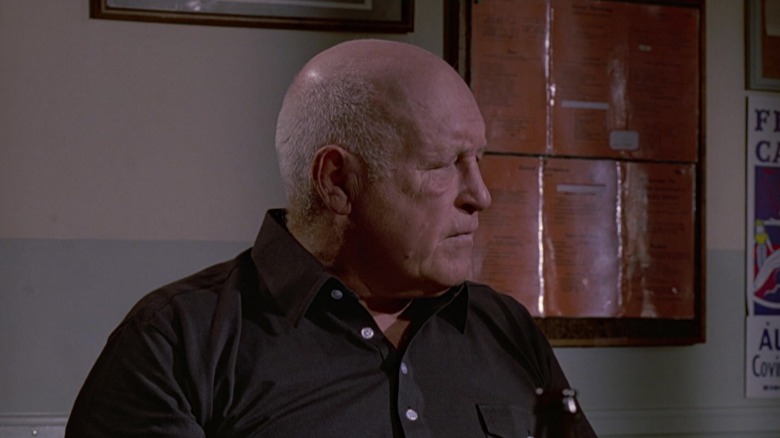
Miramax Films
Madsen, ever the rule breaker, took pleasure in flaunting the rule set by the film’s producers, and so he and co-star Tim Roth took the first opportunity they could to take Tierney out for drinks at the famed Hollywood steakhouse known as Musso and Frank’s. Tierney quickly got “really loaded,” as Madsen once told The After Movie Diner, and proceeded to walk outside onto Hollywood Boulevard and drop his pants in the middle of the street.
As if that wasn’t hectic enough, Tierney began to badger Madsen to give him 20 bucks. When Madsen declined his demand, Tierney persisted until he got so riled up he took a “wild crazy swing” at Madsen. As the latter recalled:
“I backed off, and he missed me by inches. I felt the breeze. God bless him, he’s passed away now, but he was quite a character.”
Madsen wasn’t the only one to clash with Tierney during production. Quentin Tarantino called him a “complete lunatic” by the time he made it on set, and he made their first week of shooting extremely challenging. At the very end of that week, Tarantino fired him, and “the whole crew burst into applause.”
Far from feeling empowered, Tarantino feared this would be the death knell to his career before he had even finished the first week of filming on his first movie. Luckily, one of the more responsible members of his cast, Harvey Keitel, was able to assuage the film’s producers that everything was under control, and the rest is cinema history.
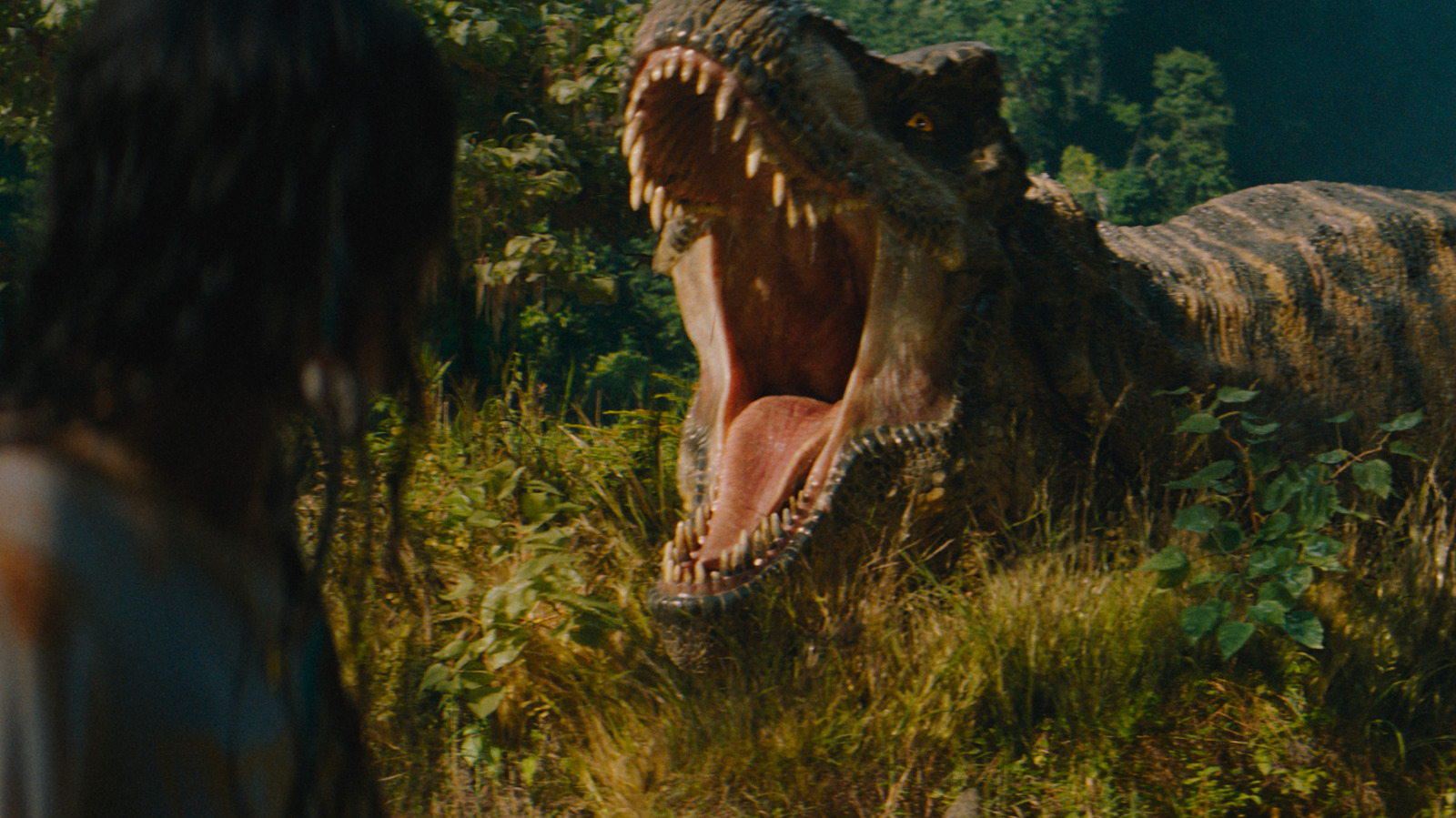
by admin | Jul 3, 2025 | TV & Beyond Articles
/Film’s review of “Jurassic World Rebirth” (written by yours truly) could generously be described as mixed negative, but here’s the thing: It doesn’t matter. The people have spoken, and the people clearly want dinosaurs on the big screen. Sadly, audiences neglected to bring that same energy to original movies like the Adam Driver-starring “65,” so Hollywood at large is now convinced that everyone’s childhood obsession can only work within the friendly confines of franchise filmmaking. Take a long look in the mirror and think about what you’ve done, folks.
Still, even the most ardent “Jurassic Park” purists would have to admit that the dino-mayhem on display in the “Jurassic World” movies are well worth the price of admission, and the same holds true in “Rebirth.” And in the hands of director Gareth Edwards, the extinct reptiles (not lizards!) have rarely looked better. That includes fan-favorite throwbacks like the fearsome Tyrannosaurus rex, but also a bevy of new additions that we’ve never actually seen depicted on-screen before. An article about every single new dinosaur on display would probably take all day to read, so we’ve rounded up the most significant ones — and one familiar face that’s undergone a startling makeover since the last time we saw it — for our breakdown here.
Naturally, this involves getting into spoiler territory, so read on only if you’ve already watched “Jurassic World Rebirth.”
Spinosaurus (sort of)
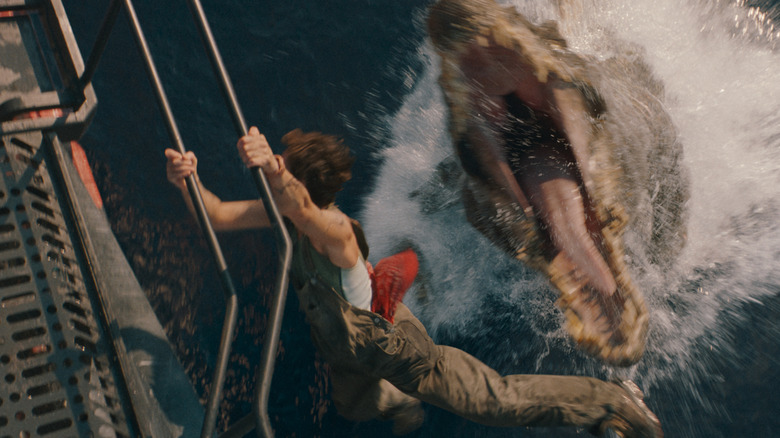
Universal Pictures and Amblin Entertainment
Scientifically-accurate dinosaurs? In my “Jurassic World” movies??? The recent sequels won’t exactly win over the hearts and minds of any paleontologists out there, but they have at least tried to make these movie monsters somewhat more reflective of their real-life counterparts. Naturally, that can’t help but ruffle a few feathers out there. (Get it? Feathers? Because we now know several dinosaurs had feathers? Keep up with me, people.) But the biggest swing yet comes in the form of what “Rebirth” does to the Spinosaurus during one of the earliest set pieces in the film, when our hapless humans make the mistake of interfering with a Mosasaurus (which we’ve seen in “Jurassic World” before) on its own home turf.
This ain’t your daddy’s Spinosaurus, though. Fans will remember the lumbering, massive, and downright terrifying version of the dinosaur from “Jurassic Park III” — you know, the one that pooped out fully-functioning satellite phones, was given the preternatural ability to find our very specific human protagonists no matter where they were on the island, and had the gall to snap the neck of our beloved T-Rex like the villain it is. This time around, well, casual viewers would be forgiven for thinking that these Spinos in “Rebirth” are a completely different animal altogether. As it turns out, Gareth Edwards and his design team decided to tweak things significantly. These new versions are smaller, hunt in packs, and most notably seem right at home in aquatic environments. All of this reflects actual research and theories of how scientists believe Spinosaurus truly lived all those tens of millions of years ago, which any dinosaur nerd can appreciate.
Titanosaurus
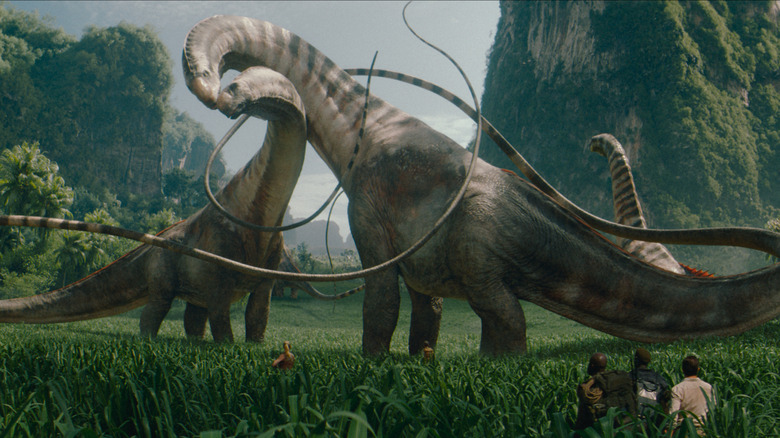
Universal Pictures and Amblin Entertainment
One of my all-time favorite pastimes is smugly correcting every filthy casual who assumes that every long-necked dinosaur they see is either a Brachiosaurus or Brontosaurus. Believe it or not, there were many more types of sauropod species (the scientific term for these giant herbivores) than that. The original “Jurassic Park” brought the majestic Brachiosaurus to the front and center of our lexicon, but “Rebirth” features a very different — though distantly related — family member in the form of the towering Titanosaurus.
Described in the film as the largest dinosaur on Earth, the Titanosaurus plays a major role in “Rebirth.” Our mercenary group, led by Scarlett Johansson’s Zora Bennett, must recover DNA extracts from three of the biggest animals currently on Earth. The Titanosaurus is one of them and, ironically, the only actual dinosaur of the trio (as the Mosasaurus and Quetzalcoatlus belong to different groups of extinct mammals, completely unrelated to dinos). In real life, paleontologists have only ever discovered fragments of skeletons, which means a lot of guesswork has gone into how they actually looked and functioned. “Jurassic World Rebirth” takes plenty of creative liberty here, adding small but memorable sail features on their backs and even depicting two in the throes of lovemaking. (True Gareth Edwards fans, going back to his 2010 indie debut “Monsters” and the MUTOs in “Godzilla,” know that he’s been single-handedly trying to bring back monster-f***ing.)
The Titanosaurus also provides the most overt reference to the original “Jurassic Park,” as composer Alexandre Desplat shows off his take on John Williams’ classic theme to convey the awe and wonder of the biggest animals to ever walk the planet.
Aquilops
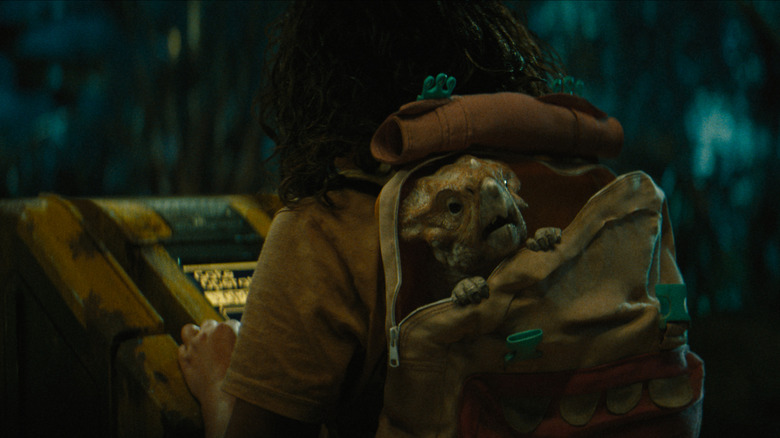
Universal Pictures and Amblin Entertainment
Dolores stans, rise up! The “Jurassic” movies have always kept kids at the forefront of these adventures, but “Rebirth” adds a whole new twist in the form of the cuddliest, most adorable little dino you’ve ever seen. Clearly hoping to take advantage of the Baby Groot and Baby Yoda phenomenon, the creative team decided to add their own version in the form of Dolores. She makes her introduction to the film when the Delgado family, shipwrecked and rescued by the mercenaries before ending up stranded on different parts of the island, stumbles across the tiny dino on their way to get help at a nearby facility. Naturally, the rambunctious preteen Isabella (Audrina Miranda) basically decides to adopt Dolores as her pet and take her with her wherever they go.
Although never actually stated in dialogue, this herbivore belongs to the species known as Aquilops. Far less famous than its cousin, the Triceratops, the Aquilops still has it beat in terms of cuteness. Most interestingly, it appears Dolores isn’t even a baby — this is (more or less) the size of full-grown members of this species. Admittedly, this is yet another dinosaur with all sorts of gaps in the fossil record, so maybe hold off on cloning your own version as a kid-friendly pet. Ultimately, Dolores doesn’t actually do much to affect the plot of the movie, but who are we to deny the merchandising potential at play here? Does this pretty much contradict the original movie’s themes about marketing and capitalism run amok? Probably. Are we still looking forward to getting a Dolores plushie of our own? You bet.
The Mutadon
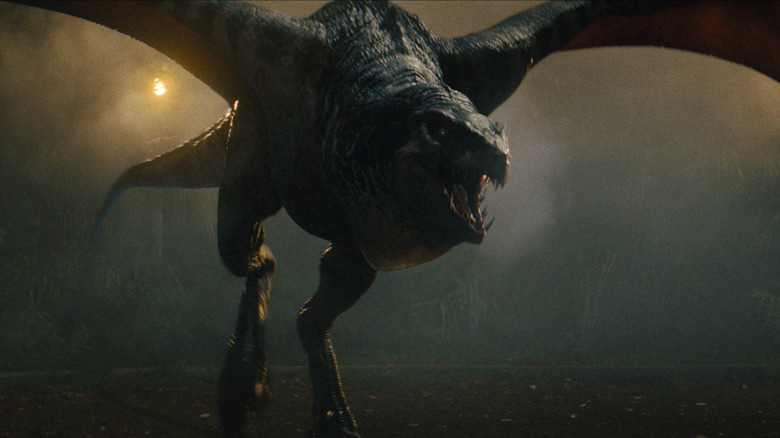
Universal Pictures and Amblin Entertainment
On the exact opposite end of the spectrum from Dolores is the Frankenstein’s monsters known as Mutadons. An unholy mashup of Velociraptors and winged Pteranodons, this represents the weirdest possible extreme of bioengineers attempting to clone theme park attractions that would win over jaded mass audiences who apparently got tired of “normal” dinos. This continues a thread that began in the 2015 “Jurassic World,” in which genetic splicing and mutant dinosaurs became the newest trend. In “Rebirth,” the Mutadon makes its first appearance as part of a clever fake-out moment. Just as familiar-looking Velociraptors close in Xavier (David Iacono), one of the castaways trying to survive on the island, a Mutadon attacks and inadvertently “saves” him from becoming lunch.
The Mutadons later show up in force when the humans finally make it to an abandoned facility to await rescue. These creatures are nastier, more formidable, and truly monstrous compared to their more “natural” counterparts, but there’s a good reason for that. Mutadons are basically the proof-of-concept experiments gone horribly wrong, abandoned and left behind once it became clear that they wouldn’t be a good fit for the actual park. As writer David Koepp once told Empire:
“Those came from my strange mind. We saw in some of the previous ‘Jurassic World’ movies that their experiments made dinosaurs bigger, meaner, scarier, and it occurred to me and Steven [Spielberg] that those can’t all have gone well.”
The Distortus rex
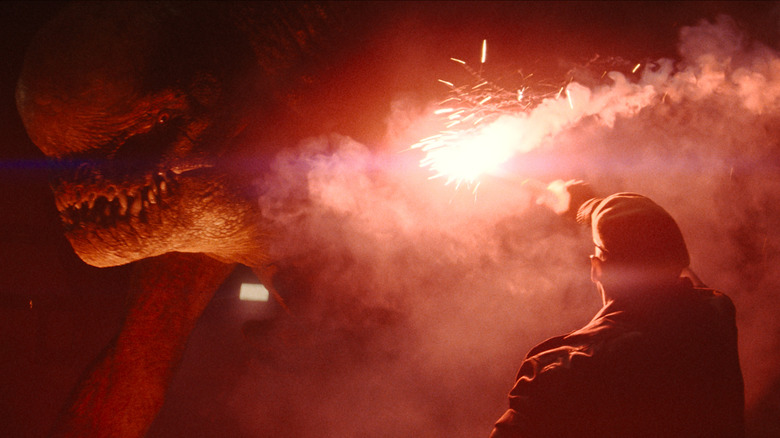
Universal Pictures and Amblin Entertainment
I don’t know if anyone ever really wondered what would happen if they crossed a Rancor from “Star Wars” and a Xenomorph from “Alien” with a T-Rex into one mutant nightmare, but “Jurassic World Rebirth” answers that for us anyway. Meet the Distortus rex, by far the ugliest and jankiest-looking dinosaur ever featured in one of these movies. This evolutionary dead end was responsible for a ton of pre-release hype, as audiences waited on the edge of their seats to see just how it might factor into the events of the film. The screenplay essentially decides to bookend the movie with the D-Rex, first opening with a prologue set almost two decades prior showing how the beast escaped confinement in the first place. The final act brings it back to the fore, terrorizing our cast just as rescue appears within arm’s reach.
True to form, the D-Rex might as well be the type of monster you encounter in “Resident Evil” — six limbs, a horrifically disfigured head, and a mean streak to rival that of any of the big bads ever featured in the franchise before. Sure, it might’ve made for a more entertaining film if the D-Rex was used like the Spinosaurus in “Jurassic Park III,” constantly appearing and haunting our heroes every step of the way like a slasher villain before going out in a blaze of glory at the end. But, as it turns out, director Gareth Edwards consciously chose not to follow that route in “Rebirth.” Unlike the grand dino-on-dino conclusions of “Jurassic Park” and the 2015 “Jurassic World,” the D-Rex doesn’t tussle with any other creature and simply retreats into the jungles once the characters escape. Could it reappear in a sequel? Stay tuned.
“Jurassic World Rebirth” is now playing in theaters.
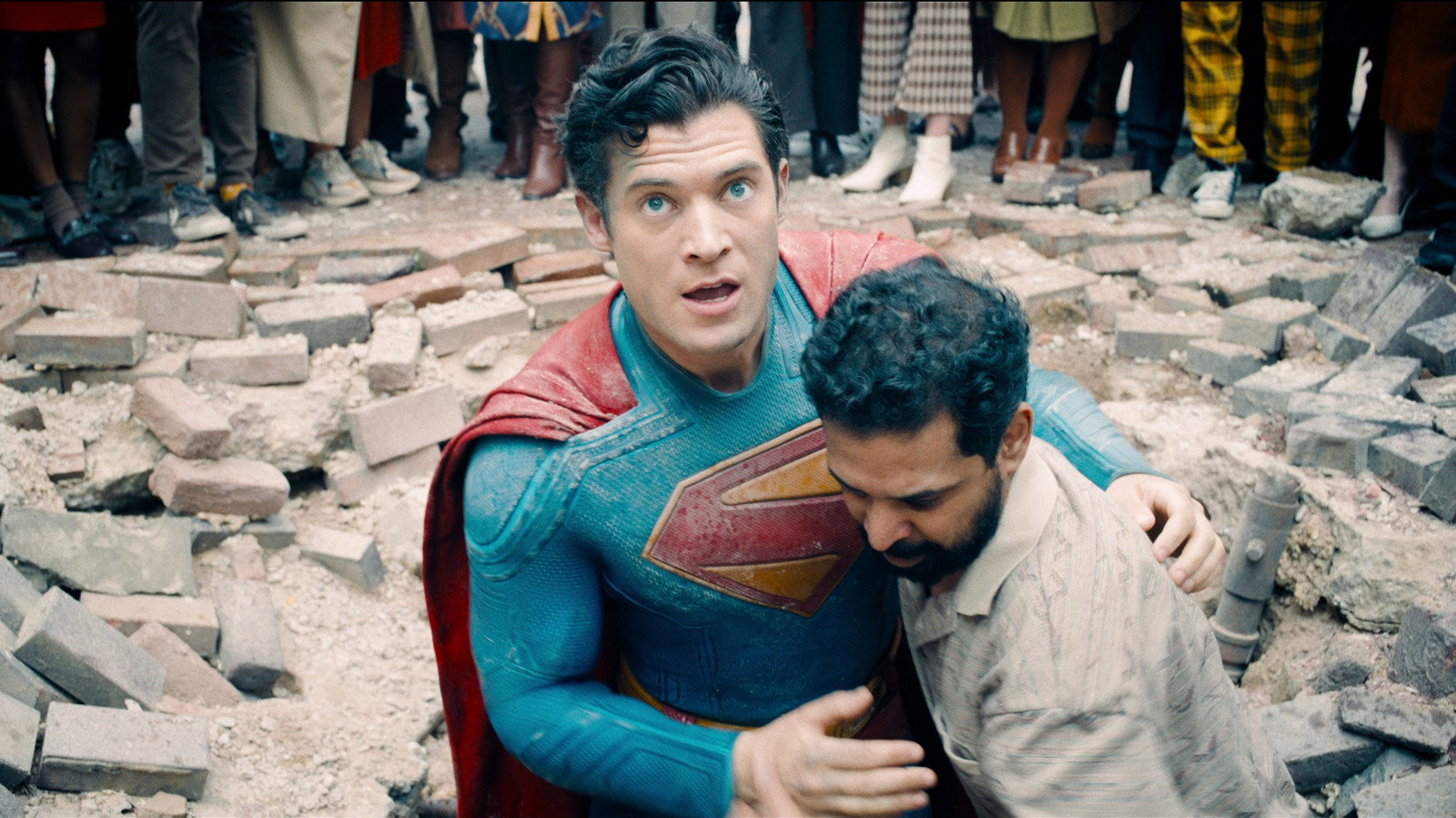
by admin | Jul 3, 2025 | News, TV & Beyond Articles
all due respect to “Creature Commandos”). Gunn, known best as the director of Marvel’s “Guardians of the Galaxy” trilogy, is heading up DC Studios alongside producer Peter Safran. The question is, can this reboot of DC’s golden boy get the revamped DCU off to a better start than the DC Extended Universe (DCEU) got over a decade ago?
As of this writing, “Superman” is expected to pull in between $130 and $171 million domestically when it opens next weekend, per Box Office Theory. Those numbers are just ever so slightly down from early projections, which had Gunn’s film pulling in anywhere between $90 and $185 million, depending on who you talked to. Meanwhile, mid-June tracking had the blockbuster pulling in over/under $135 million, per The Hollywood Reporter.
Warner Bros. previously launched its first shared live-action DC cinematic universe, aka the DCEU, with director Zack Snyder’s “Man of Steel” in 2013, just one year after Christopher Nolan’s “The Dark Knight Rises” wrapped up his Batman trilogy. Snyder’s take on Superman, which starred Henry Cavill, opened to $116.9 million domestically, which was, by 2013 standards, a solid launch.
“Man of Steel” finished its run at the box office with $668 million worldwide against a reported $225 million budget. Interestingly enough, Gunn’s “Superman” is said to carry a very similar production budget. What’s interesting is that, unadjusted for inflation, if pre-sales cool down and this movie opens even a little below current projections, it could have a near-identical opening to Snyder’s divisive take on the titular character. 12 years later and yet so much remains the same.
Superman needs to set the new DC Universe up for success
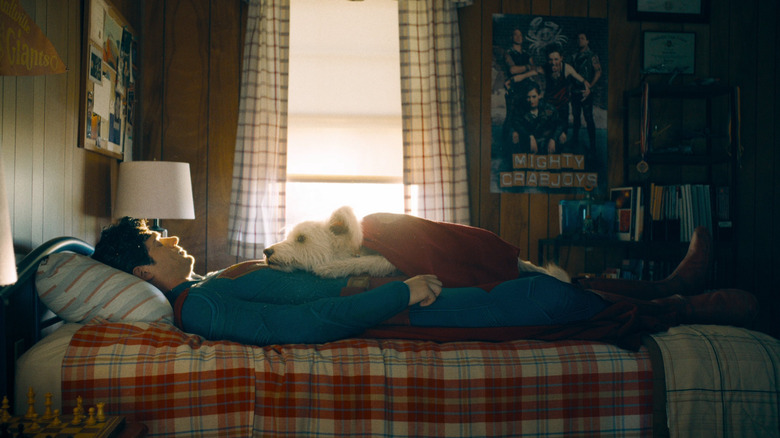
Warner Bros.
Broader plot details for “Superman” have surprisingly been kept mostly under wraps. The trailers have made it clear that it’s not an origin story and that there will be several villains for Supes to contend with. Among those joining David Corenswet (Clark Kent/Superman) in the cast are Rachel Brosnahan (Lois Lane), Nicholas Hoult (Lex Luthor), Isabela Merced (Hawkgirl), Nathan Fillion (Guy Gardner), and Edi Gathegi (Mister Terrific).
The problem largely is that box office tracking has become far less reliable of late. Recently, for example, “M3GAN 2.0” was on course to earn $30 million weeks before it opened to a mere $10 million. On the flip side, there are movies that blow past projections like “A Minecraft Movie,” which has had the biggest domestic opening of 2025 so far with $162.7 million. Critical buzz could be the X factor here. If critics and early audiences love Gunn’s “Superman,” an opening closer to $150 million could be in the cards. But if buzz cools as the weekend nears? $100 million might seem more realistic.
To be clear, only two films — “A Minecraft Movie” and “Lilo & Stitch” — have opened to more than $100 million domestically so far in 2025. So, anything north of $100 million would be a huge deal for WB. That’s also just one part of the equation, as international audiences are going to play a major factor here. “Man of Steel” made nearly 57% of its money overseas. But pre-sales in China have been soft for “Superman,” with competition from the likes of “Jurassic World Rebirth” being a consideration.
For WB, Gunn, and Safran, this is about more than one movie. They have lofty plans, with “Supergirl” and “Clayface” slated to hit theaters next year, along with “Lanterns” on HBO Max. That means “Superman” has to help get audiences on board with a new DC Universe. But that doesn’t have to mean $1 billion at the box office. “Iron Man” made $585 million, and the Marvel Cinematic Universe was built on its back. The pressure is certainly on, but let’s also not burden this movie with unreasonable expectations either.
“Superman” hits theaters on July 11, 2025.































